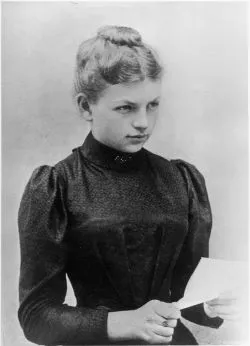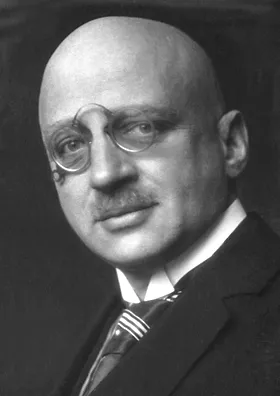Fritz Haber’s Experiments in Life and Death
The German chemist helped feed the world. Then he developed the first chemical weapons used in battle
/https://tf-cmsv2-smithsonianmag-media.s3.amazonaws.com/filer/Bombs-hero.jpg)
In April of 1915, Allied forces were battling the German Army for control of Ypres, a Flemish town in western Belgium. Months before, fighting with many young and untested soldiers, the Germans had taken heavy casualties there in a battle they called the Massacre of the Innocents of Ypres. This time, they were determined to launch their first major attack on the Western Front. With thousands of French, British, Belgian and Canadian forces dug in around the town, the Germans turned to Fritz Haber.
In 1918, Haber would be awarded the Nobel Prize in chemistry for his work in developing a method of synthesizing ammonia from nitrogen in the air—the process that enabled the production of fertilizer in quantities that revolutionized agriculture worldwide. But in the winter of 1915, Haber’s thoughts turned to annihilating the Allies. For his efforts directing a team of scientists on the front lines in World War I, he would become known as the father of chemical warfare.
Fritz Haber was born in Breslau, Prussia (now Wroclaw, Poland), in 1868, and educated at the St. Elizabeth Classical School, where he took an early interest in chemistry. After studying at the University of Berlin, he transferred to the University of Heidelberg in 1886 and studied under the famed German chemist Robert Bunsen. Haber was ultimately appointed professor of physical chemistry and electrochemistry at the Karlshruhe Institute of Technology. When scientists warned that the world would not be able to produce enough food to feed its growing human population in the 20th century, he listened.
Scientists knew nitrogen was crucial to plant life; they also knew the earth’s supply of usable quantities was quite limited. But Haber discovered a way to convert the nitrogen gas in the earth’s atmosphere into a compound that could be used in fertilizer. According to Vaclav Smil, a global agricultural historian at the University of Manitoba in Winnipeg, the Haber–Bosch process of synthesizing and manufacturing ammonia from nitrogen and hydrogen (and later industrialized by Carl Bosch, Haber’s brother-in-law) was likely the most important technological innovation of the 20th century. It sustains the food base for the equivalent of half the world’s population today.

In 1901, Haber married the brilliant chemist Clara Immerwahr, the first woman to receive a doctorate from Breslau University. Years before, she’d spurned a marriage proposal from him to focus on her studies and career. Like Haber, she converted from Judaism to Christianity, and the couple settled in Karlsruhe. But it wasn’t long before Clara Haber’s research took a back seat to the demands of being a homemaker and, after the birth of their son in 1902, a mother.
To keep her mind stimulated, she began collaborating with her husband on a textbook on the thermodynamics of gas, and tried to continue her own research, writing and speaking. As her husband’s reputation spread, she was incensed to learn that her audiences assumed that he had written her lectures. Meanwhile, Haber’s career flourished, and around the start of World War I, the German Army requested his help in the development of replacing explosives in shells with poison gasses.
Haber, unlike his friend Albert Einstein, was a German patriot, and he willingly became a uniformed consultant to the German War Office. During World War I, he began drawing on experiments he’d done on using chlorine gasses as a weapon. Finding an effective delivery system was challenging—one test resulted in the deaths of several German troops. But by 1915, defeats on the front lines hardened Haber’s resolve to use gas weapons, despite Hague Convention agreements prohibiting chemical agents in battle.
Haber had a difficult time finding any German army commanders who would agree even to a test in the field. One general called the use of poison gas “unchivalrous”; another declared that poisoning the enemy “just as one poisons rats” was “repulsive.” But if it meant victory, that general was willing to “do what must be done.” Haber, according to biographer Margit Szollosi-Janze, “said if you want to win the war, then please, wage chemical warfare with conviction.”
Clara Haber, however, condemned her husband’s weapons work as a “perversion of the ideals of science” and “a sign of barbarity, corrupting the very discipline which ought to bring new insights into life.” Publicly, she pleaded with him to end his experiments in chemical warfare. Privately, Haber said her statements amounted to treason. Their marriage suffered further as Haber traveled frequently and philandered.
In 1914, as Director of the Kaiser Wilhelm Institute for Physical Chemistry, Haber placed his laboratory at the service of the German government, and by April of 1915, he was on the front lines in Ypres, in uniform, smoking cigars and calculating the timing of what he hoped would be a lethal gas attack. Thousands of steel cylinders containing chlorine gas had been transported to German positions. There would be no launching or dropping of the gas on Allied troops; instead, Haber calculated, the best delivery system was the prevailing winds in Belgium. After weeks of waiting for ideal winds—strong enough to carry the gas away from the German troops, but not so strong they would dissipate the gas weapons before they could take effect against the enemy—the Germans released more than 168 tons of chlorine gas from nearly 6,000 canisters at sunrise on April 22. A sickly cloud, one witness told the New York Times, “like a yellow low wall,” began to drift toward the French trenches.
The cloud settled over some 10,000 troops. More than half were believed to have died by asphyxiation within minutes.
Lance Sergeant Elmer Cotton, a Canadian soldier who was gassed at Ypres and survived, described the attack as “an equivalent death to drowning only on dry land. The effects are there—a splitting headache and terrific thirst (to drink water is instant death), a knife edge of pain in the lungs and the coughing up of a greenish froth off the stomach and the lungs, ending finally in insensibility and death. It is a fiendish death to die.

As thousands of French troops fled, blinded and stunned, the Germans opened fire. Then, after the cloud had dissipated, they captured 2,000 prisoners of war, confiscating rifles and urging the afflicted French to lie down “to die better.”
In the confusion, initial reports said the Germans were launching “chloride bombs” that were “thrown by means of a hand sling, such as boys use for throwing stones.” The Washington Post reported that British and French troops were “Crazed by Gas Bombs,” and that those who survived “fought like demons,” but to no avail.
Haber’s gas weapons were so effective that German troops were actually rattled by the Allies’ rapid retreat. They advanced slowly, believing that they were walking into a trap, and missed an opportunity for a breakthrough.
Two days later, however, they attacked Canadian positions with another chlorine dose and followed it up with heavy bombardment. That assault led to nearly 7,000 Canadian casualties, including 1,000 fatalities.
The Second Battle of Ypres saw casualties of nearly 70,000 Allied troops, but only half as many Germans, owing largely to what is considered the first large-scale use of chemical weapons. Fritz Haber was soon after given the rank of captain, and on May 2, 1915, he returned to his home in Berlin to attend a party in his honor. The next day, he was to travel to the Eastern Front to initiate another gas attack, against the Russians.
Hours after the party for her husband, Clara Immerwahr wandered into the garden with Haber’s Army pistol. She pointed the gun to her heart and pulled the trigger, taking her life. His wife’s suicide did not delay his deployment to the Eastern Front. The unpredictability of the wind’s effect on chlorine gas released from cylinders prompted the Germans to eventually develop gas-filled shells that could fired over distances. By the end of the war, the Germans were using mustard gas on Allied troops, but improvements in gas masks and filters for various chemicals enabled the Allies to adapt.
Despite his Nobel Prize, Haber’s postwar life was hardly filled with honors. He was despondent over the German defeat, and felt responsible for the debilitating German war debt. As Hitler rose to power, Nazis attacked both him and the Kaiser Wilhelm Institute for harboring Jewish scientists. The Christian convert became “Haber the Jew” in the eyes of the Nazi regime, and rather than fire his staff as requested, Haber resigned and fled Germany for England. But scientists there shunned him for his work with chemical weapons. He traveled Europe, fruitlessly searching for a place to call home, then suffered heart failure in a hotel in Switzerland in 1934. He passed away shortly thereafter at the age of 65, but not before repenting for devoting his mind and his talents to wage war with poison gasses.
Praised for his work that still enables agriculture around the world, yet condemned for his work on chemical weapons, Fritz Haber personified the extremes of technological innovation in the 20th century. It was, however, a kind twist of fate that Haber never lived to see Zyklon B, a poisonous gas developed in the 1920s at the laboratory that he ran, used on some of his own relatives who had were ultimately sent off to Nazi concentration camps.
Sources:
Books: L.F. Haber, The Poisonous Cloud: Chemical Warfare in the First World War, Oxford University Press, 1986. Daniel Charles, Master Mind: The Rise and Fall of Fritz Haber, the Nobel Laureate Who Launched the Age of Chemical Warfare, Ecco, 2005.
Articles: Germans Gain; Big New Battle On Near Ypres, New York Times, April 24, 1915. Bomb Fumes Reach 2 Miles, New York Times, April 25, 1915. Asphyxiating Gas Used by Germans, Declares French, Atlanta Constitution, April 24, 1915. Crazed By Gas Bombs, Washington Post, April 26, 1915. Effects of Poison Bombs, New York Times, April 24, 1915. German Press Admits Use of Gaseous Bomb, Chicago Tribune, April 26, 1915. Fritz Haber: Chemist and Patriot, The Woodrow Wilson National Fellowship Foundation, http://www.woodrow.org/teachers/ci/1992/haber.html Clara Immerwahr, 1870-1915, by Jutta Dick, Jewish Women Encyclopedia, http://jwa.org/encyclopedia/article/immerwahr-clara The Nobel Prize in Chemistry 1918: Fritz Haber, Nobelprize.org, http://www.nobelprize.org/nobel_prizes/chemistry/laureates/1918/haber-bio.html The Tragedy of Fritz Haber: Nobel Laureate Transformed Wold Food Production, War, by Dan Charles, NPR, http://www.npr.org/programs/morning/features/2002/jul/fritzhaber/ The Second Battle of Ypres, 1915, FirstWorldWar.com, http://www.firstworldwar.com/battles/ypres2.htm Gas Warfare During the First World War, http://www.webmatters.net/history/ww1_gas_03.htm Chlorine Gas, Spartacus Educational, http://www.spartacus.schoolnet.co.uk/FWWchlorine.htm
/https://tf-cmsv2-smithsonianmag-media.s3.amazonaws.com/accounts/headshot/gilbert-king-240.jpg)
/https://tf-cmsv2-smithsonianmag-media.s3.amazonaws.com/accounts/headshot/gilbert-king-240.jpg)